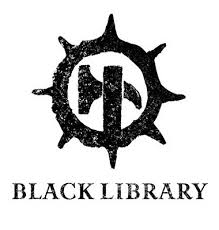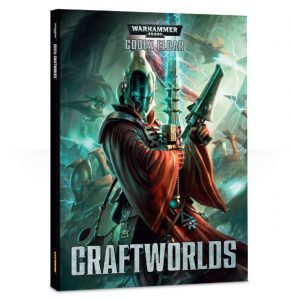Thinking Outside the (Game) Box
 Writing for the Black Library comes with a simple, undeniable truth: one is working on a world and stories primarily created so that people can collect, paint and fight miniature battles with toy soldiers. The contents of the rulebooks, supplements and White Dwarf magazine underpin everything else. Players of the games view it as a defining feature of the setting but as an author you must be aware of the game but not beholden to it.
Writing for the Black Library comes with a simple, undeniable truth: one is working on a world and stories primarily created so that people can collect, paint and fight miniature battles with toy soldiers. The contents of the rulebooks, supplements and White Dwarf magazine underpin everything else. Players of the games view it as a defining feature of the setting but as an author you must be aware of the game but not beholden to it.
Codex Schmodex
A very large part of this understanding must come from the way an author views the rules and troop types as delivered in the books for the game. For Warhammer 40,000 these revolve around the Codexes (yes, that is the correct plural in this instance, it being the trademark, rather than codices) and the army lists they contain.
The army lists exist to allow players to collect their miniatures and form them into forces upon the tabletop. They reflect the society and organisation of the factions to a certain degree, and the basic make-up of an armed force from that faction, its leaders and weapons.
All of which is very handy when two strangers meet over a tabletop battlefield but should never get in the way of writing a good story or creating a memorable character. Quite often a story needs the exceptional to happen. Very often, particularly in representing the more regimented military forces such as the Space Marines and Astra Militarum, the army lists portray a ‘paper organisation’ – that being what a squad should look like, how many units are organised in a platoon, company, etc. Pages of the Codexes are given over to these structural factors that shape how the army list was created from the fiction.
They are never to be mistaken for the ‘reality’ of the setting. The practicality of casualties, fluctuating command structures, battlefield logistics and the base cunning of the regular infantryman, all mean that stuff happens that isn’t detailed in the books.
As an example, there were many instances throughout World War Two of soldiers taking the weapons and equipment of the enemy – German Wehrmacht troops on the Eastern Front were initially woefully unprepared for the winter and took gear from dead Russians, for example, and many Soviet submachine guns (PPSh-41) were captured and issued to German troops. Conversely, Allied soldiers often took the more reliable German weaponry.
 For instance, there might not be an entry in an army list that allows a regular Imperial Guard squad to be carried around in a Valkyrie gunship, but you might concoct a story in which said squad, at the end of a bloody and fragmented campaign, end up doing so in order to launch a last attack for victory or death. Ignoring the confines of the army list gives rise to a remarkable and story-worthy narrative. The exception provides the drama.
For instance, there might not be an entry in an army list that allows a regular Imperial Guard squad to be carried around in a Valkyrie gunship, but you might concoct a story in which said squad, at the end of a bloody and fragmented campaign, end up doing so in order to launch a last attack for victory or death. Ignoring the confines of the army list gives rise to a remarkable and story-worthy narrative. The exception provides the drama.
So while the universe of Warhammer 40,000 is riven with dogma and superstition and blind adherenece to rules, we must also remember that the occasional quirk that does not ‘follow the Codex’ is perfectly acceptable, nay desirable. This is in no way an excuse to get it wrong through lack of research, always be aware of the rules you are breaking, but also one shouldn’t be hidebound about opportunities to be characterful.
One of the most successful fictional characters, Ibram Gaunt by Dan Abnett, was introduced as a Commissar-colonel. No such rank or position had ever existed in the Imperial Guard background; it may have been intentional or a misreading by Dan, you’ll have to ask him. It did, though, make Gaunt a unique character from the outset, and thus worthy of writing about, and apparently everyone agrees as Gaunt’s Ghosts continues to be Black Library’s most popular Imperial Guard series by a long way.
All the Tales to be Told
Part and parcel of this attitude, and something I talk about in my Author’s Notes for Azrael, is that when writing Warhammer 40,000 it’s easy to fall into a narrow mindset. We look at the soldiers, we see the lasers and power armour, and we default to thinking of Military Sci-fi as the subgenre in which we are writing.
Resist this urge! Warhammer 40,000 is SF in only the most tangential ways, home to powerful technology but possessing very little of the scientific mindset, and while all stories from Black Library will be connected in some way to the motto “There is Only War!” as authors we need to push beyond a simple war story interpretation.
40K is a baroque fantasy married to a dystopian horror crushed against the thrashing corpse of space opera. It can be anything you want it to be, and though battles may feature heavily, the story is rarely about the battles. As I’ve said before in other posts the plot of the story and what the story is about are not the same thing.
This is also true of structure. Your story could actually be based on the pacing, style and tropes of detective fiction, or take on the trappings of urban fantasy, historical epic, cyberpunk, magical realism… Paranormal romance might be pushing it, but that could probably be done too with enough of a sidestep.
 Miss Marple isn’t likely to be deducing the death of a ganger in the depths of the Underhive, but if you do a bit of study, understand how story structure works in various genres and subgenres, it’s possible to see how the breadth of the 40K setting can give rise to all sorts of stories. To follow the example, the death of the ganger may seem inconsequential against the backdrop of a Tyranid invasion of the hive city, but for the squad of Space Marine scouts that discover him, deducing the movements of the Lictor that killed him becomes a matter of life and death, and that means gathering up all the relevant clues.
Miss Marple isn’t likely to be deducing the death of a ganger in the depths of the Underhive, but if you do a bit of study, understand how story structure works in various genres and subgenres, it’s possible to see how the breadth of the 40K setting can give rise to all sorts of stories. To follow the example, the death of the ganger may seem inconsequential against the backdrop of a Tyranid invasion of the hive city, but for the squad of Space Marine scouts that discover him, deducing the movements of the Lictor that killed him becomes a matter of life and death, and that means gathering up all the relevant clues.
My personal favourite would be a whodunnit set aboard a traitor Leviathan command transport, in which the villain is revealed to be a polymorphine-disguised Callidus assassin.
My point is that when thinking about what you could write for 40K, if a submissions window comes up, your first thought should be regarding the sort of story you want to tell. When you have that in mind you can figure out how to weave in the horrific beauty of the Warhammer 40,000 setting.
That is not to say that any story would work if you just throw in some cod-latin Imperial Gothic and a Space Marine. The horror, the overarching decay and themes of despotism and despair, the study of fascistic power, decadence, superstition, the lure of Chaos and the threat of the unknown are all intrinsic to a ‘proper’ Warhammer 40K story – but the structure and style of that story is not defined by the setting.
To put it another way… There is no such thing as a typical 40K story, only great stories set in the Warhammer 40,000 universe.
I’ve been so busy recently that I’ve neglected the Writing Advice section of my website – something I’ll try to remedy in 2017. If there are any topics you would like me to cover, leave a comment below and I’ll add them to my list.
**To make sure you don’t miss out on any blog posts, you can keep up-to-date with everything Gav by signing up to my monthly newsletter. As a bonus, every other month I randomly pick a newsletter subscriber to receive a free signed copy of one of my books.**
Please Feel Free to Share:










